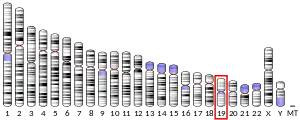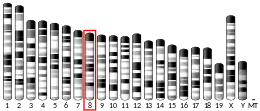MCOLN1
Mucolipin-1 also known as TRPML1 (transient receptor potential cation channel, mucolipin subfamily, member 1) is a protein that in humans is encoded by the MCOLN1 gene.[5] It is a member of the small family of the TRPML channels, a subgroup of the large protein family of TRP ion channels.
TRPML1 is a 65 kDa protein associated with mucolipidosis type IV. Its predicted structure includes six transmembrane domains, a transient receptor potential (TRP) cation-channel domain, and an internal channel pore.[6] TRPML1 is believed to channel iron ions across the endosome/lysosome membrane into the cell and so its malfunction causes cellular iron deficiency.[7] It is important in lysosome function and plays a part in processes such as vesicular trafficking, exocytosis and autophagy.[8][9]
See also
- transient receptor potential cation channel, mucolipin subfamily, member 2 (MCOLN2)
- transient receptor potential cation channel, mucolipin subfamily, member 3 (MCOLN3)
- mucolipidosis type IV
- TRPML
References
- GRCh38: Ensembl release 89: ENSG00000090674 - Ensembl, May 2017
- GRCm38: Ensembl release 89: ENSMUSG00000004567 - Ensembl, May 2017
- "Human PubMed Reference:". National Center for Biotechnology Information, U.S. National Library of Medicine.
- "Mouse PubMed Reference:". National Center for Biotechnology Information, U.S. National Library of Medicine.
- Clapham DE, Julius D, Montell C, Schultz G (December 2005). "International Union of Pharmacology. XLIX. Nomenclature and structure-function relationships of transient receptor potential channels". Pharmacol. Rev. 57 (4): 427–50. doi:10.1124/pr.57.4.6. PMID 16382100. S2CID 17936350.
- Venugopal B, Browning MF, Curcio-Morelli C, Varro A, Michaud N, Nanthakumar N, Walkley SU, Pickel J, Slaugenhaupt SA (November 2007). "Neurologic, gastric, and opthalmologic [sic] pathologies in a murine model of mucolipidosis type IV". Am. J. Hum. Genet. 81 (5): 1070–83. doi:10.1086/521954. PMC 2265643. PMID 17924347.
- Dong X, Cheng X, Mills E, Delling M, Wang F, Kurz T, Xu H (2008). "The Type IV Mucolipidosis-Associated Protein TRPML1 is an Endo-lysosomal Iron Release Channel". Nature. 455 (7215): 992–6. doi:10.1038/nature07311. PMC 4301259. PMID 18794901.
- Wang W, Zhang X, Gao Q, Xu H (2014). "TRPML1: an ion channel in the lysosome". Handbook of Experimental Pharmacology. 222: 631–45. doi:10.1007/978-3-642-54215-2_24. PMID 24756723.
- Di Paola S, Scotto-Rosato A, Medina DL (January 2018). "TRPML1: The Ca(2+)retaker of the lysosome". Cell Calcium. 69: 112–121. doi:10.1016/j.ceca.2017.06.006. PMID 28689729.
- Schmiege P, Fine M, Blobel G, Li X (October 2017). "Human TRPML1 channel structures in open and closed conformations". Nature. 550 (7676): 366–370. doi:10.1038/nature24036. PMC 5920536. PMID 29019983.
External links
- GeneReviews/NIH/NCBI/UW entry on Mucolipidosis IV
- mucolipin-1+protein,+human at the US National Library of Medicine Medical Subject Headings (MeSH)




